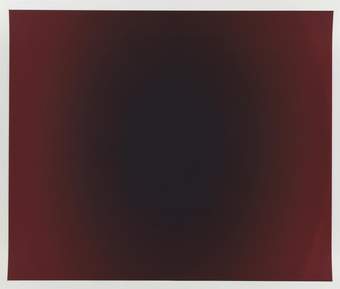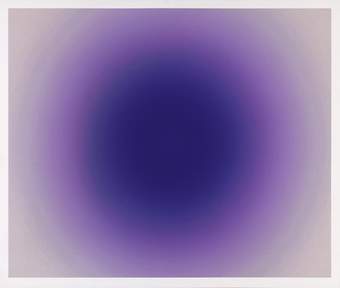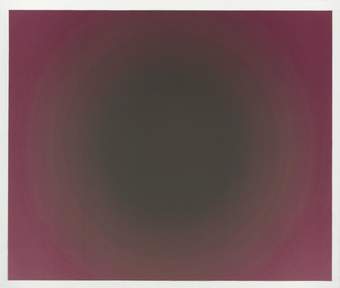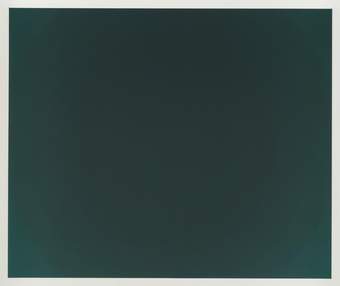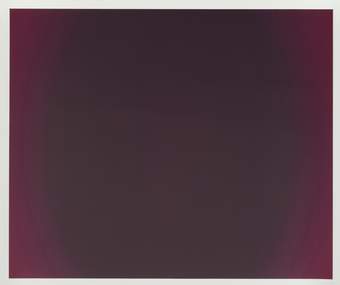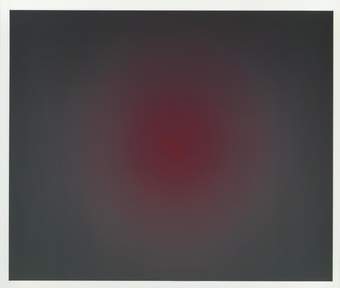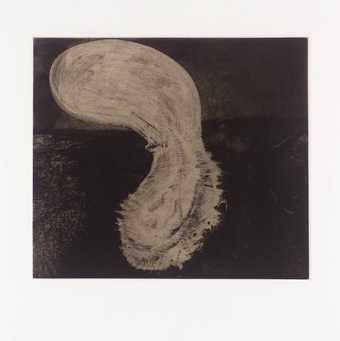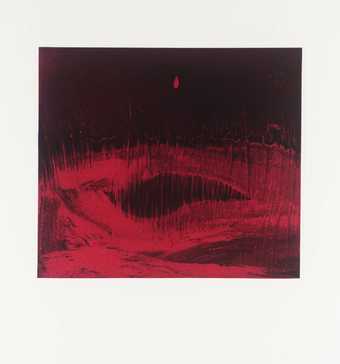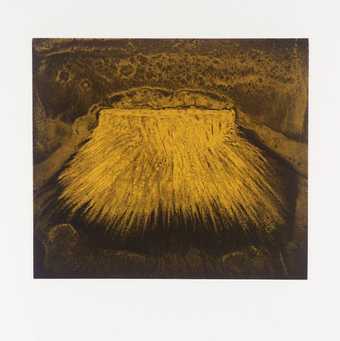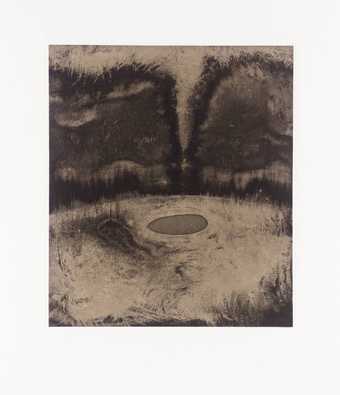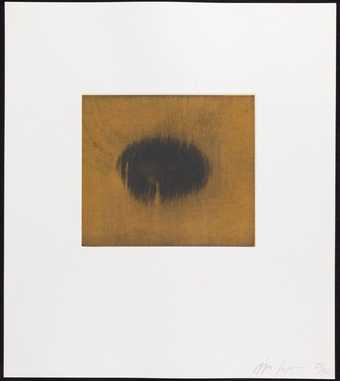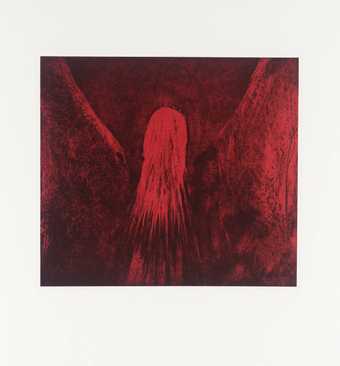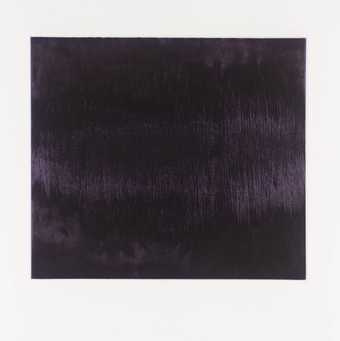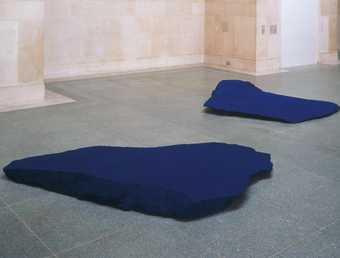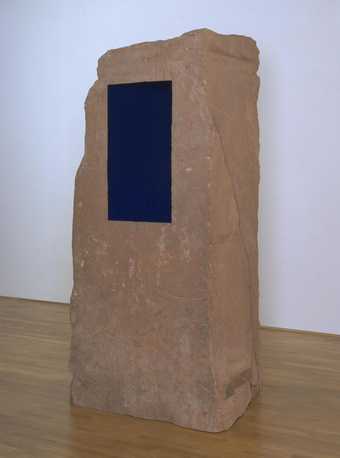
On loan
National Art Center (Tokyo, Japan): Light
- Artist
- Sir Anish Kapoor CBE RA born 1954
- Medium
- Fibreglass, resin and lacquer
- Dimensions
- Object: 3150 × 2500 × 2240 mm
- Collection
- Tate
- Acquisition
- Presented by Tate International Council 2005
- Reference
- T12004
Summary
Ishi’s Light is a large, floor-standing sculpture, which rises to a height of over three metres. Its ground plan is crescent shaped, and its form ovoid: a huge, incomplete egg shell, cut off horizontally and therefore open at the base and top. The wide opening in the structure seems to invite the spectator to step inside. With a diameter of two and a half metres at its widest point, it is tall and wide enough for this. Indeed, Kapoor intends that the spectator become a participant in the work by standing inside it. Whereas the exterior of the shell is of fibreglass, and of a slightly translucent stone colour, the interior is lacquered in deep red, so dark it is almost black, and with a gloss suggesting the highly finished surface of a grand piano. The shiny interior creates a reflective, though distorting and inverting, surface. Light entering the structure creates a strip of brightness that has an almost tangible quality. Kapoor has explained: ‘As you’re entering the work, the column of light is like a virtual object, it’s a physical object. It isn’t simply on the surface. I think something is occurring there with the reflections, which is what is important to me.’(Quoted in Nayeri and Ramirez.)
The name of the sculpture refers to the artist’s son, Ishan, and the title deliberately evokes a work by the Minimalist painter Barnett Newman (1905–70), called Anna’s Light 1968 (Kawamura Memorial Museum of Art, Sakura, Japan). Anna’s Light, named for the artist’s mother, is Newman’s largest painting. Both works use highly saturated reds but the tones are very different. Kapoor’s dark and enveloping blood red in the interior of Ishi’s Light nevertheless seems to echo the effect of the brilliant and suffusing red pigment of Anna’s Light. The older artist’s impact on Kapoor’s work is long standing. As an art student Kapoor saw Newman’s large red painting Vir Heroicus Sublimis 1950–1 (Museum of Modern Art, New York), which was a formative experience for him. He explains:
When you stand in front of this huge work, it is as though it ceases to be a picture. It completely surrounds and engulfs you. It astounded me that art could step out of narrative so completely; that art could seem to have nothing to say, and yet engage all the truly important things that there are to say. Of course, in talking about Newman I’m talking about myself.
(Quoted in Gayford, p.106.)
Kapoor’s use of a reflective, encompassing interior surface for Ishi’s Light evokes the wider use of mirrors that became a major characteristic of his work from the mid 1990s. Here, as in such works as Her Blood 1998 (T11763), distortions and inversions created by reflective surfaces modify the spectator’s sense of space and even his or her sense of self. When standing inside Ishi’s Light the space creates not only optical but also aural distortions, as sounds seem remote within the sculpture’s hollow interior. The form of the work is reminiscent of the emptiness of Kapoor’s ‘void’ sculptures of the late 1980s and early to mid 1990s, which are characterised by the use of blocks punctuated by an empty recess, and inverted, funnel-like forms that disappear into walls and floors. However, the deep red, womb-like interior of Ishi’s Light suggests warmth and security. The spectator who stands within the work occupies a liminal zone, a place that is not really a place but rather has the sense of being between different realms.
Further reading
Nicholas Baume, ed., Anish Kapoor: Past, Present, Future, exhibition catalogue, Institute of Contemporary Art, Boston 2008, reproduced p.106.
Martin Gayford, ‘All Or Nothing’, Apollo, vol.167, June 2008, pp.104–7.
Farah Nayeri and Marisa Ramirez, ‘Sculptor Anish Kapoor Talks About 9/11 Memorial, India, Money’, 16 February 2005, http://www.bloomberg.com/apps/news?pid=10000102&sid=amP1_M3NI95w&refer=uk [accessed 22 December 2008].
Alice Sanger
December 2008
Does this text contain inaccurate information or language that you feel we should improve or change? We would like to hear from you.
Display caption
The distortions created by the reflective surfaces of this sculpture change our sense of space. Kapoor wanted to create the feeling of being immersed in an artwork. He named the work after his son Ishan. But he was also inspired by his experience of an abstract painting - Anna’s Light 1968 - by Barnett Newman. Kapoor wrote of it: ‘It completely surrounds and engulfs you. It astounded me that art could step out of narrative so completely; that art could seem to have nothing to say, and yet engage all the truly important things that there are to say. Of course, in talking about Newman I’m talking about myself.’
Gallery label, June 2020
Does this text contain inaccurate information or language that you feel we should improve or change? We would like to hear from you.
Explore
- abstraction(8,615)
-
- non-representational(6,161)
-
- geometric(3,072)
You might like
-
Sir Anish Kapoor CBE RA [no title]
1998 -
Sir Anish Kapoor CBE RA [no title]
1998 -
Sir Anish Kapoor CBE RA [no title]
1998 -
Sir Anish Kapoor CBE RA [no title]
1998 -
Sir Anish Kapoor CBE RA [no title]
1998 -
Sir Anish Kapoor CBE RA [no title]
1998 -
Sir Anish Kapoor CBE RA [no title]
2000 -
Sir Anish Kapoor CBE RA [no title]
2000 -
Sir Anish Kapoor CBE RA [no title]
2000 -
Sir Anish Kapoor CBE RA [no title]
2000 -
Sir Anish Kapoor CBE RA [no title]
2000 -
Sir Anish Kapoor CBE RA [no title]
2000 -
Sir Anish Kapoor CBE RA [no title]
2000 -
Sir Anish Kapoor CBE RA A Wing at the Heart of Things
1990 -
Sir Anish Kapoor CBE RA Adam
1988–9

